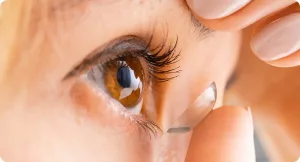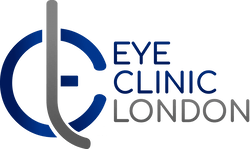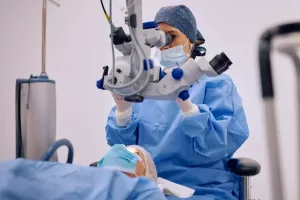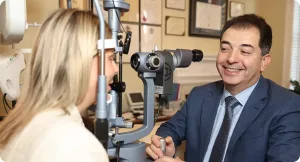Top 5 Treatment Options for Keratoconus – What You Need to Know

If you or someone close to you has been diagnosed with keratoconus, chances are you’ve been thrown into a whirlwind of unfamiliar words, options, and overwhelming decisions. It’s hard to know where to start. What works? What doesn’t? And how do you know which treatment is right for your eyes — or your life?
Keratoconus affects each person differently, but you are not alone: it’s estimated impact as many as 1 in 200 people globally, and advances in treatment have dramatically changed what’s possible.
This article is here to help. Whether you’re newly diagnosed or your condition has progressed over time, understanding your treatment options can restore a sense of clarity and control. Here, we’ll break down the top five treatments for keratoconus — from glasses to cutting-edge biologic implants — in real, useful terms.
This isn’t a theory lesson. It’s the practical guide you wish you had at diagnosis.
Glasses and Soft Contact Lenses – The First Step
In the earliest stages of keratoconus, your vision might still be correctable with something as simple as glasses or standard soft contact lenses. These are usually the first line of defence after diagnosis — and for many people, they can provide decent clarity in day-to-day life, particularly if the corneal changes are still mild.
At this stage, your optician or ophthalmologist may notice subtle irregularities in the shape of your cornea that don’t yet cause major distortion. Glasses might help with mild astigmatism or blurry vision, and soft lenses can improve comfort and visual sharpness for some time.
But keratoconus is progressive. Over time, the cornea thins and bulges more into a cone shape, distorting how light enters the eye. As this happens, your vision may become harder to correct with regular lenses. You might find that:
- Your glasses prescriptions change frequently
- Things look slightly “off” even with new lenses
- Lights at night develop halos or starbursts
- Words on a page or screen appear ghosted or doubled
- Contrast and sharpness aren’t what they used to be
These are all signs that your keratoconus is advancing — and that glasses or soft lenses alone may no longer be enough.

Importantly, struggling with vision despite updated prescriptions is not something to ignore or “put up with.” It’s a signal that more specialised treatment options — such as rigid contact lenses, cross-linking, or other corneal therapies — may be needed to preserve your sight.
Early intervention makes a big difference. If you’re starting to experience these visual distortions, speak to a keratoconus specialist about what’s next. With today’s technologies, there are safe and effective ways to protect your vision long before surgery is ever considered.
Specialised Contact Lenses – RGP and Scleral Lenses
When glasses no longer do the trick, the next option is contact lenses — but not just any lenses. In keratoconus, the goal isn’t just to correct vision, it’s to physically create a smooth optical surface over the misshapen cornea.
There are several types of contact lenses used in keratoconus, including:
- Rigid Gas Permeable (RGP) Lenses: These small, hard lenses rest directly on the cornea and provide sharp vision by masking the irregular corneal shape. They can feel uncomfortable initially, but many people adapt well over time.
- Hybrid Lenses: These have a rigid centre with a soft outer ring. They combine the clarity of RGP lenses with improved comfort.
- Scleral Lenses: These are larger lenses that rest on the white part of the eye (the sclera) and vault over the cornea entirely, leaving a tear-filled space in between. This not only improves comfort and vision but also provides moisture for dry or sensitive eyes. For many people with moderate to advanced keratoconus, scleral lenses are a game-changer.
Fitting these lenses takes time — and expertise. You may need multiple fittings and follow-ups. But once the right lens is found, the improvement in visual clarity can be life changing.
Corneal Cross-Linking (CXL) – Stopping the Progression
If your keratoconus is still progressing — and particularly if you’re under 30 — you’ll likely be offered a procedure called corneal cross-linking (CXL). This is the only treatment proven to halt the progression of keratoconus by strengthening the corneal tissue.
The procedure involves:
- Applying riboflavin (vitamin B2) eye drops
- Activating them with ultraviolet (UV-A) light
This combination triggers a chemical reaction that increases collagen cross-links in the cornea — making it more rigid and resistant to further bulging.
There are two main types of CXL:
- Epithelium-Off (Epi-Off): The surface layer of the cornea is removed to allow better riboflavin penetration. This version is more common and has the most long-term data.
- Epithelium-On (Epi-On): The surface is left intact, reducing discomfort and recovery time but with potentially less penetration.
Most people don’t notice a big change in vision immediately after cross-linking — and that’s normal. The goal is not to improve sight, but to preserve what you have. However, some do report mild improvement over time as the cornea stabilises.
It’s often combined with lenses, Intacs, or other procedures to achieve optimal vision correction after stabilisation.
Intacs – Reshaping from Within
Intacs are small, crescent-shaped plastic rings that are surgically inserted into the peripheral cornea. Their purpose is to flatten the cone and make the cornea more regular — improving vision and contact lens tolerance.
They’re typically considered when:
- Vision isn’t correctable with glasses
- Lenses are not well tolerated
- Cross-linking alone isn’t enough
The procedure is quick (usually 10–15 minutes), done under local anaesthetic, and reversible. Vision improves gradually as the rings reshape the cornea over weeks or months.
Note: Intacs don’t stop keratoconus progression — that’s why they’re often used alongside cross-linking. Their main benefit is improving quality of vision and delaying the need for transplant in borderline cases.
KeraNatural – The New Biological Frontier
KeraNatural is one of the most exciting innovations in keratoconus treatment. Unlike synthetic implants or tissue removal, this technique uses reshaped, sterilised human corneal tissue to restore strength, shape, and clarity to the natural cornea.
Here’s how it works:
- Donor corneal tissue is laser-shaped to fit an individual’s cornea
- It is implanted within the stroma to restore natural thickness and curvature
- The result is a biomechanically stable and optically regular cornea — without the need for full transplantation
KeraNatural sits between cross-linking and transplant on the treatment spectrum. It’s ideal for patients with moderate to advanced keratoconus who still have enough healthy tissue but need more than structural support.
Benefits include:
- Reduced rejection risk compared to traditional grafts
- No need to remove the host cornea
- Improved visual outcomes when combined with contact lenses
It’s not yet universally available, but in centres where it’s offered, outcomes have been promising — and it’s gaining international attention.
Corneal Transplant – When Nothing Else Works
In about 10–20% of keratoconus cases, the condition progresses to a point where non-surgical options are no longer effective. When vision can’t be corrected even with the most advanced lenses — or when the cornea becomes dangerously thin, scarred, or structurally unstable — a corneal transplant may be the only remaining option.
But what exactly is a corneal transplant? And what type might you need?
Types of Corneal Transplants in Keratoconus
1. DALK (Deep Anterior Lamellar Keratoplasty)
This is the preferred type of graft for keratoconus in most cases. It involves removing only the damaged front layers of the cornea, while preserving the patient’s own healthy inner layer (the endothelium).
Benefits include:
- Lower risk of graft rejection.
- Better long-term graft survival.
- Less impact on intraocular structures.
- Often allows for faster healing than full-thickness grafts
2. PK (Penetrating Keratoplasty)
In a full-thickness transplant, the entire cornea is removed and replaced with donor tissue. This may be necessary if the back layer of the cornea (the endothelium) is also damaged — which can occur in cases of advanced scarring, hydrops (a complication of keratoconus), or failed previous grafts.
Benefits and trade-offs:
- Can restore clarity when all layers are affected.
- Slightly higher risk of rejection and complications.
- Longer visual recovery time (often 6–12 months)
Why Early Diagnosis Matters
A transplant is a significant procedure — and while outcomes are generally good, it’s something most people would prefer to avoid if possible. The best way to prevent the need for a corneal graft is through early diagnosis and timely intervention.
Procedures like corneal cross-linking can stop keratoconus from worsening if caught early enough. Advanced contact lenses like scleral lenses or KeraNatural inlays can provide clear, stable vision and delay or eliminate the need for surgery altogether.
Unfortunately, many people delay seeking help — either because they think their symptoms are “just astigmatism” or because their vision loss has been gradual. But waiting too long can lead to irreversible corneal damage and fewer treatment options down the line.
What to Expect After a Transplant
Corneal transplants are highly successful — but recovery takes time and care:
- You may need stitches for several months.
- Vision typically improves slowly and stabilises over 6 to 12 months.
- Glasses or lenses are often still needed, but with better clarity.
- Regular follow-up is essential to monitor for rejection or complications.
Most patients achieve very functional vision and return to daily life, but the journey requires patience.
In Summary:
Corneal transplants offer hope when other treatments have failed — but the goal is always to avoid getting to that point. If you’ve been told you have keratoconus, don’t wait. Modern treatments are more effective than ever at protecting your sight, especially when started early.
Which Option Is Right for You?
There’s no single “best” treatment. The right approach depends on:
- Your age
- How fast your condition is progressing
- How distorted your vision is
- How comfortable you are with lenses
- What treatments are available where you live
Often, a combination is used: cross-linking to halt progression, scleral lenses to improve vision, and later KeraNatural or Intacs to reshape the cornea.
The key is early diagnosis and regular follow-up. The sooner keratoconus is identified, the more options you’ll have — and the better your long-term outcome will be.
Final Thoughts
Keratoconus isn’t just one diagnosis — it’s many stages, many variations, and many journeys. But with modern treatments, the outlook has never been better.
From the simplicity of glasses in the early days, to the sophistication of biologic inlays like KeraNatural, the treatment landscape is evolving fast. Whether you’re in the first months of your diagnosis or weighing options after years of contact lens wear, know this: there is always something that can be done.
Talk to your specialist, explore your options, and don’t settle for struggling. Clearer, sharper, more stable vision is possible — and closer than you think.
Frequently Asked Questions About Keratoconus Treatments
- What is the best treatment for keratoconus?
There’s no one-size-fits-all answer. The best treatment depends on how advanced your condition is. Early cases might be managed with glasses or soft lenses, while progressive cases often require cross-linking. For more advanced or irregular corneas, scleral lenses, Intacs, or even KeraNatural may be recommended. - How do I know if I need cross-linking?
Corneal cross-linking (CXL) is typically recommended when your keratoconus is actively progressing — meaning your corneal scans show increasing steepness or thinning over time. You may also notice worsening vision, increased ghosting, or more frequent prescription changes. If your scans show stability, cross-linking may not be immediately necessary, but regular monitoring is key. - What’s the right age to have cross-linking?
There’s no “perfect age.” CXL can be effective at nearly any age if the cornea is still responsive and not too scarred or thin. It’s often performed in younger patients because their condition tends to progress more quickly, but many people in their 30s, 40s, and 50s undergo successful cross-linking. The right time is when progression is documented — not when you reach a certain age. - How long does cross-linking last?
Cross-linking is designed to be permanent. For most people, it halts keratoconus progression long-term. However, rare cases of mild progression can still occur, particularly if the procedure is done at a very early stage or before the cornea has fully stabilised. - Are scleral lenses uncomfortable or hard to wear?
Not at all. In fact, many people find scleral lenses more comfortable than standard hard lenses because they don’t touch the sensitive cornea. They can take some getting used to, but they often provide excellent vision and comfort for people with moderate to advanced keratoconus. - Can I have both cross-linking and KeraNatural?
Yes — and they often complement each other. Cross-linking strengthens the cornea, while KeraNatural restores shape and thickness. For patients needing both stability and improved structure, combining these treatments can lead to better visual outcomes. - Do Intact improve vision without contact lenses?
Intacs can slightly improve unaided vision, but they’re usually used to help patients tolerate contact lenses more comfortably. They flatten the cornea just enough to make lens fitting easier and reduce distortion. - Is KeraNatural available on the NHS or only privately?
As of now, KeraNatural is mostly available in specialist centres or private clinics like Eye Clinic London under the care of Mr Hamada. It’s a newer biologic option and not yet offered widely across NHS settings. Availability is expanding as more results support its use. - Will I need a corneal transplant one day?
Most people with keratoconus do not need a transplant — especially with today’s treatments like CXL, scleral lenses, and KeraNatural. Only about 10–20% of patients progress to the point of needing surgery, usually after exhausting all other options. - Can I stop wearing lenses after cross-linking?
Cross-linking stops progression but doesn’t correct vision. You’ll likely still need lenses (often scleral) or glasses afterward. Think of cross-linking as preserving your vision, not restoring it — that’s where lenses or reshaping treatments come in. - Is there a cure for keratoconus?
There’s no complete cure — but there are highly effective treatments that stop it in its tracks and improve vision. Many patients with keratoconus live full, active lives with excellent vision, thanks to modern care and personalised treatment plans.
Final Thoughts
Living with keratoconus can feel overwhelming, especially when your vision starts to change in ways that glasses alone can’t fix. But the good news is, you have options—and the sooner you explore them, the better your chances of stabilising your sight and preventing further deterioration. From the simplicity of custom lenses to the promise of corneal cross-linking and surgical innovations, there’s no one-size-fits-all answer. The best treatment really depends on your specific diagnosis, how far the condition has progressed, and your lifestyle needs.
Early detection is key. Regular eye exams and prompt referrals to a specialist can make all the difference in preserving your vision for the long term. If you’ve recently been diagnosed or are concerned about worsening symptoms, don’t wait. Speak to your optometrist or ophthalmologist about the full range of available treatments and which might be right for you.
If you are suffering from keratoconus, you can get in touch with us here at Eye Clinic London to consult with one of our expert ophthalmologists. We’ll take the time to assess your condition thoroughly and help you explore the treatment options best suited to your needs.
Modern keratoconus care is no longer just about managing symptoms—it’s about active intervention, stabilisation, and even vision improvement. And with ongoing research and better technology, the future is looking clearer than ever.
References:
- Gomes, J.A.P., Tan, D., Rapuano, C.J., Belin, M.W., Ambrósio, R., Guell, J.L., Malecaze, F., Nishida, K. and Sangwan, V.S., 2015. Global consensus on keratoconus and ectatic diseases. Cornea, 34(4), pp.359–369. Available at: https://journals.lww.com/corneajrnl/Fulltext/2015/04000/Global_Consensus_on_Keratoconus_and_Ectatic.4.aspx
- NHS, 2022. Keratoconus. NHS.uk. Available at: https://www.nhs.uk/conditions/keratoconus/
- Hersh, P.S., Stulting, R.D., Muller, D., Durrie, D.S., Rajpal, R.K. and United States Crosslinking Study Group, 2017. United States multicenter clinical trial of corneal collagen crosslinking for keratoconus treatment. Ophthalmology, 124(9), pp.1259–1270. Available at: https://www.aaojournal.org/article/S0161-6420(17)30954-3/fulltext
- Rabinowitz, Y.S., 1998. Keratoconus. Survey of Ophthalmology, 42(4), pp.297–319. Available at: https://www.sciencedirect.com/science/article/abs/pii/S0039625797001197
- American Academy of Ophthalmology, 2023. What Is Keratoconus? aao.org. Available at: https://www.aao.org/eye-health/diseases/what-is-keratoconus



